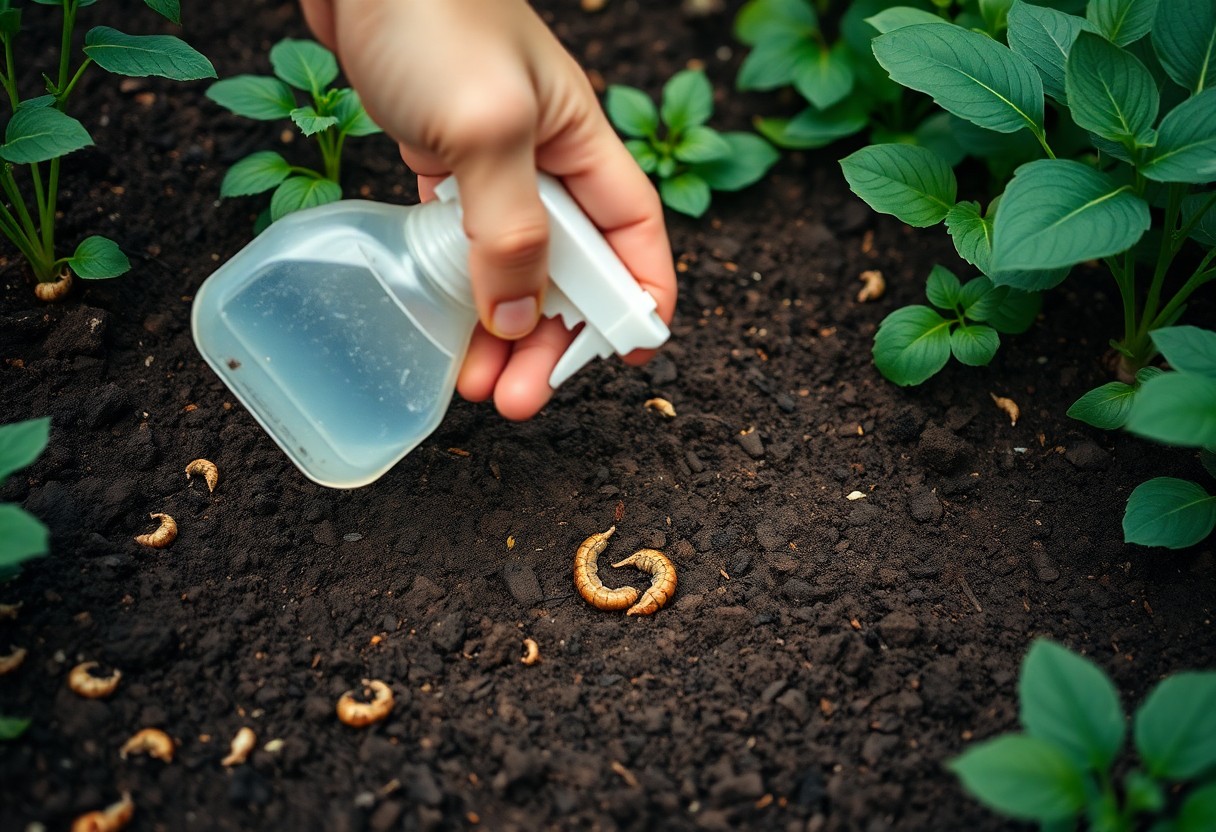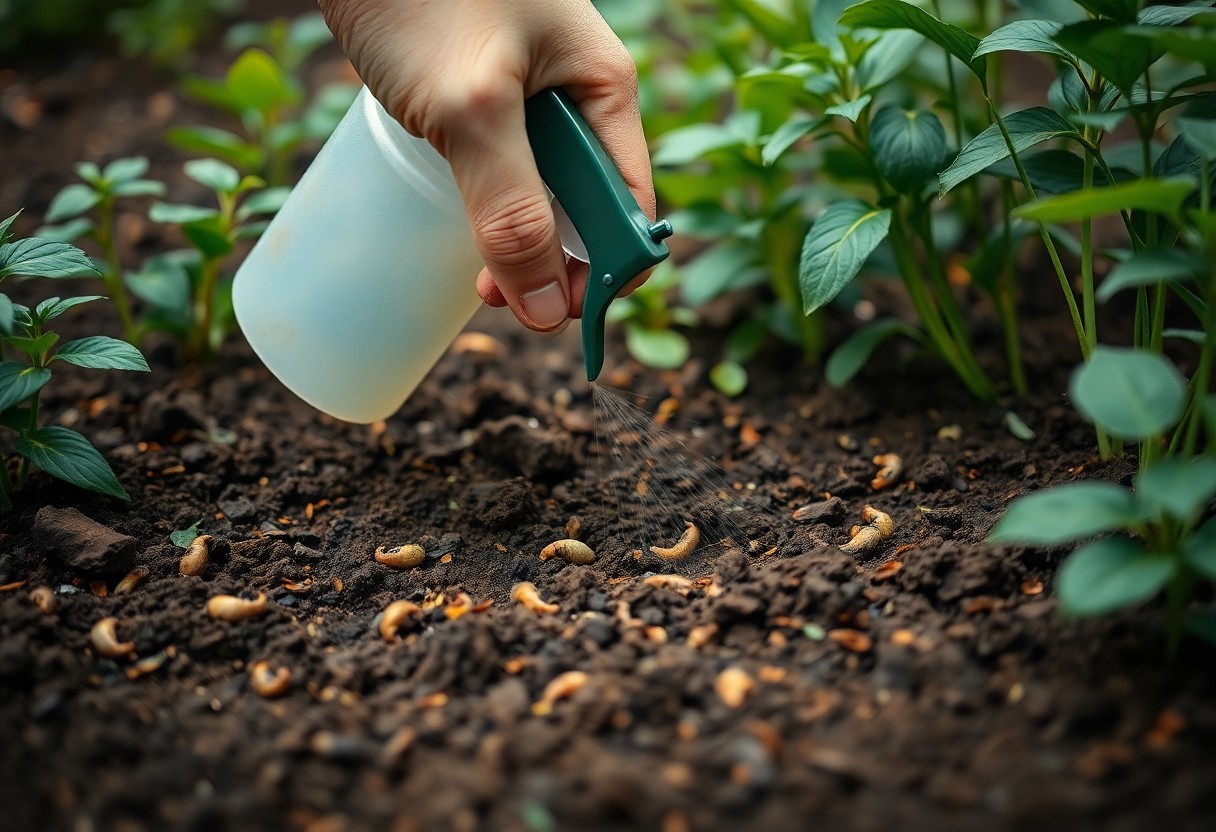Over time, grubs can destroy your garden’s health by feeding on plant roots and damaging the soil ecosystem. If you’re noticing signs of these pests in your garden, it’s vital to act quickly. This guide will walk you through the most effective methods to eliminate grubs swiftly, ensuring your plants remain vigorous and thriving. You’ll learn how to identify grubs, choose the right treatments, and implement preventative measures to protect your garden soil, allowing you to maintain a flourishing outdoor space.
Key Takeaways:
- Incorporating beneficial nematodes into the soil can effectively target and kill grubs without harming beneficial insects.
- Maintaining proper lawn care practices, such as regular aeration and watering, can create a less favorable environment for grubs to thrive.
- Applying natural insecticides, like neem oil or diatomaceous earth, can provide a safe alternative for controlling grub populations in your garden.

Understanding Grubs in Garden Soil
To effectively manage grubs in your garden soil, it’s important to understand their life cycle and behavior. Grubs are the immature larvae of beetles, and they thrive in moist, rich soil. They feed on plant roots and decaying organic matter, which can lead to significant damage to your garden. Recognizing the signs of grub activity early can save your plants and ensure a healthier garden environment.
What are Grubs?
Soil is home to various organisms, and grubs belong to the larval stage of beetles, typically seen in turf and garden areas. They appear as C-shaped white or cream-colored larvae with soft bodies and a brown head. Grubs can vary in size depending on their age, and they play a role in the ecosystem but can become problematic when populations explode.
Identifying Grub Infestation
After noticing brown patches or wilting plants in your garden, it’s time to inspect for grubs. Signs of infestation often include a spongy feel to the soil and increased activity from animals like birds and skunks that dig for grubs. Checking the soil by turning over a section will reveal if grubs are present.
But you should actively monitor your garden for signs of trouble. Spotting grubs early can prevent severe damage to your plants. Look for patches of browning grass or plants, as this is often a telltale sign of infestation. If you find more than a few grubs in a small section, it can indicate a serious issue that needs addressing to protect your garden. Keeping an eye out for these indicators can help maintain the health of your soil and overall garden health.
Causes of Grub Infestation
The presence of grubs in your garden soil can often be traced back to several factors. Various environmental conditions combined with improper gardening practices can create a perfect breeding ground for these harmful pests.
Environmental Factors
Against the backdrop of your garden, certain environmental factors play a significant role in grub infestation. These include:
- Moisture levels: High moisture can attract female beetles to lay eggs.
- Temperature: Warm soil promotes optimal conditions for grubs to thrive.
- Soil composition: Loose, organic soil may favor their proliferation.
Perceiving how these elements affect grub populations helps you make informed decisions to combat them effectively.
Gardening Practices
Against common misconceptions, your gardening practices may inadvertently encourage grubs to flourish in your soil. Your approach to fertilization, irrigation, and pest control can either deter or attract these pests.
Environmental factors such as over-watering promote damp conditions that are optimal for grub development, while using excessive fertilizers can create nutrient-rich environments that attract adult beetles for egg-laying. It’s vital to implement balanced watering routines, focus on organic pest control, and practice soil health management to discourage grub presence. By revising your gardening practices, you can significantly decrease grub populations in your garden.
Prevention Strategies
Once again, implementing effective prevention strategies is imperative for keeping grubs out of your garden soil. Start by practicing crop rotation and avoiding monocultures, as these can attract grubs. Additionally, maintaining a healthy garden environment through proper watering, mulching, and weed management can deter grubs. Lastly, consider using organic amendments and plant cover crops to promote beneficial microbes, providing a natural defense against these pests.
Soil Health Improvement
Along with prevention, focusing on soil health improvement is vital. You can enhance your soil’s fertility by adding organic matter, such as compost or well-rotted manure, which encourages beneficial microorganisms that can outcompete grubs for resources. Regular soil testing will guide you in making informed amendments, ensuring that your garden thrives and remains less attractive to pest infestations.
Beneficial Insects and Natural Predators
Any gardener can benefit from introducing beneficial insects and natural predators into their ecosystem. These allies actively prey on grubs and other pest species, helping to naturally regulate their populations without the need for chemical interventions.
With a diverse garden ecosystem, your plants can thrive while also warding off common pests. Ladybugs, lacewings, and parasitic wasps are just a few examples of beneficial insects that help control grub populations effectively. You can attract these natural predators by planting native flowers and herbs, which provide imperative habitats and food sources. By fostering a healthy balance of beneficial insects, you can significantly reduce grub activity while promoting the overall health of your garden.
Biological Control Methods
Despite the presence of grubs in your garden, you can effectively manage them through biological control methods. By utilizing natural predators and microorganisms, you minimize chemical use while promoting a healthy ecosystem. These methods not only target grubs but also help maintain a balance in your garden, paving the way for sustainable gardening practices.
Nematodes
To combat grubs, you can introduce beneficial nematodes into your soil, which are microscopic worms that seek out and infect these pests. They work by entering the grubs’ bodies, releasing bacteria that ultimately lead to the grubs’ demise. Using nematodes not only targets grubs effectively but also enriches your soil’s biological activity.
Milky Spore
Below, you’ll discover the power of milky spore, a natural bacterium that specifically targets Japanese beetle grubs. When applied to your garden, it multiplies in the soil, providing long-lasting control over the grub population while being harmless to beneficial insects.
Methods of applying milky spore involve spreading the granules evenly over your garden, which allows the bacteria to establish itself in the soil. As the milky spore infects the grub population, it proliferates, providing *sustained control* for up to *15 years*. This solution is *efficient and safe*, making it an ideal choice for *organic gardeners* who seek to minimize chemical inputs in their gardens while effectively managing *grub populations*.
Chemical Control Options
Not all methods of grub control are safe or environmentally friendly, but chemical options can effectively target infestations in your garden. Opting for the right chemical treatment ensures that you can address your grub problem promptly. It’s crucial to choose products that specifically mention effectiveness against grubs to minimize damage to beneficial insects.
Pesticide Types
- Insect Growth Regulators – Disrupts the development cycle of grubs.
- Contact Insecticides – Kills grubs on contact.
- Systemic Insecticides – Absorbed by plants to target grubs feeding on roots.
- Botanical Insecticides – Natural options without harsh chemicals.
- Granular Insecticides – Easy application method suitable for lawns and gardens.
This overview highlights the various pesticide types available to tackle your grub challenges effectively.
Application Guidelines
Options for applying pesticides should be executed with care to ensure effectiveness and safety. Follow all labeled instructions regarding dosage, timing, and method of application for the best results. You may prefer to apply during the early morning or late afternoon when beneficial insects are less active. Avoid spraying on windy days to minimize drift and impact on surrounding areas.
A proper application technique is vital to maximize the impact of your chosen pesticide. Make sure to wear protective clothing and consider using a sprayer for even distribution across the affected areas. Also, plan your application around rainfall to prevent runoff, which can diminish effectiveness and harm surrounding ecosystems. This attention to detail will help you achieve a robust outcome in grubs management while minimizing risks.

Best Practices for Long-Term Control
After identifying and eliminating grubs from your garden, it’s important to implement best practices for long-term control. Adopting a comprehensive approach will not only reduce the chances of future infestations but also promote healthier soil and plants. Focus on maintaining soil health, utilizing natural predators, and practicing crop rotation to create a resilient garden ecosystem.
Crop Rotation
The practice of crop rotation involves changing the types of plants you grow in specific areas of your garden each season. This method disrupts the life cycle of grubs, as they thrive on particular plant roots. By rotating your crops, you can minimize the chances of grubs re-establishing themselves in your garden.
Regular Soil Monitoring
Below are some important steps to take for effective soil monitoring. Conducting regular soil tests can provide insight into nutrient levels and pH balance, which can help you maintain optimal growing conditions. Additionally, keep a close eye on the population of grubs and other pests by inspecting your soil and plants frequently.
To foster a healthy garden environment, it’s imperative that you engage in regular soil monitoring. This proactive approach not only helps detect any potential grub infestations early on but also allows you to observe changes in nutrient levels and pH balance. By checking your soil’s condition periodically, you can make timely adjustments and introduce appropriate amendments, preventing further pest problems and enhancing the overall health of your garden.
Summing up
On the whole, to effectively eliminate grubs from your garden soil, you should consider using beneficial nematodes or organic insecticides as your first line of defense. Regularly applying these solutions can help disrupt the grub lifecycle and protect your plants. Additionally, maintaining healthy soil through proper care and aeration can prevent future infestations. By staying proactive and monitoring your garden regularly, you will create a less hospitable environment for grubs, ensuring your plants thrive throughout the growing season.
FAQ
Q: What are grubs and why are they a problem in my garden?
A: Grubs are the larval stage of various beetles and can cause significant damage to the root systems of plants in your garden. They feed on the roots, leading to plants that wilt, yellow, or die. Early detection and elimination are important to keep your garden healthy and flourishing.
Q: What are the fastest methods to eliminate grubs from my garden soil?
A: The quickest methods include using beneficial nematodes, which are microscopic worms that attack and kill grubs. Additionally, applying a pesticide specifically designed for grubs can provide rapid results. Lastly, regular tilling of the soil can expose grubs to predators and environmental conditions that cause them to perish.
Q: Are there any natural alternatives to chemical pesticides for eliminating grubs?
A: Yes, several natural alternatives include using neem oil, which disrupts the life cycle of grubs, and diatomaceous earth, which is a natural abrasive that can kill grubs by damaging their exoskeleton. Planting garlic or applying a solution of soap and water can also deter grubs from your garden.
Q: How can I prevent grubs from returning after I’ve eliminated them?
A: To prevent grubs, maintain a healthy garden by regularly aerating your soil and watering properly. You can also introduce beneficial insects, such as ground beetles and parasitic wasps, which prey on grubs. Additionally, avoiding excess thatch in your lawn can reduce the habitat for adult beetles, thereby decreasing the chances of future infestations.
Q: When is the best time to treat my garden for grubs?
A: The ideal time to treat for grubs is in the late summer to early fall when grubs are at their peak feeding stage. Applying treatments during this time can effectively disrupt their life cycle and reduce their population for the upcoming growing season. Some preventative measures can also be applied in early spring before grubs hatch.
